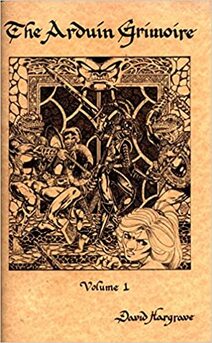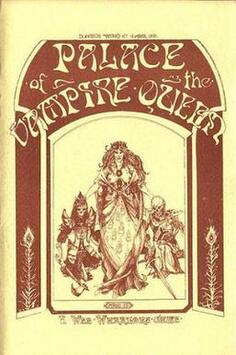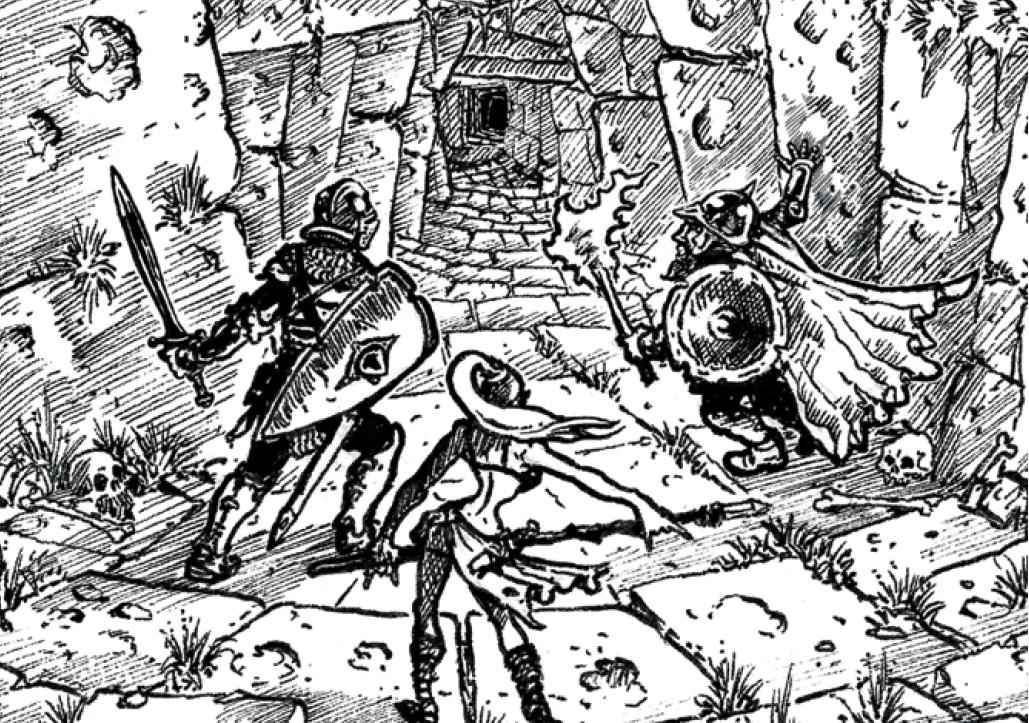Charlie Mason's minimalist retro-clone WHITE BOX has become my go-to OSR game for running D&D games online: it's simple and unfussy but delivers high-powered heroics without the fuss. It's got a charming aesthetic. It looks like an absolute peach!
An absolute peach. They really do look like bottoms, don't they?
I can't really discuss White Box without introducing its parent or clone-father, which is Marv Breig's SWORDS & WIZARDRY: WHITE BOX (2009).
SWORDS & WIZARDRY was one of the first post-OGL retro-clones: a game which took the rules to an earlier edition of D&D (which, according to Internet lore, if not the actual Law, cannot be copyrighted) and represented them in a rational, accessible format, with perhaps a few popular house rules to tweak them into compliance with 21st century sensibilities. Matt Finch had the genius idea of going right back to the Gary Gygax/Dave Arneson rules for "Original D&D".
OD&D (1974) was a wooden box with a white cover containing three digest-sized booklets, introducing 3 character classes (Fighter, Magic-User, Cleric) and 3 non-human PC races (Elf, Dwarf and Hobbit - oh, sorry, Halfing) as well as rules for combat, treasure and monsters. Five supplements followed over the next two years, introducing the Thief class, the Greyhawk and Blackmoor settings, fantasy gods, more spells and lots more monsters. Further to this, rules and classes and monsters appeared in other publications, like TSR's Strategic Review. One can only imagine the difficulty fans experienced in those pre-Internet times bringing together all these rules - and indeed the proliferation of fan-made materials (like David Hargrave's 1976 Arduin Grimoire) attests to how gamers improvised in response. Ultimately, Eric Homes' 1977 Basic Set D&D integrated everything into the game that most players of that vintage found in shops.
Then, of course, came Gary Gygax's magnum opus, Advanced Dungeons & Dragons (1977-9, infamously without credit to Dave Arneson).
Just the sight of those covers and I'm 12 years old again.
But what was Original D&D like? How did it play? There's always been a sense among D&D players that, for all Gary Gygax's erudition and obsession, something was lost when the game moved from the wild frontier of OD&D to the surburban streetplans of AD&D. There was a fall from grace. There's a hankering to go back, back before the serpent and the angel with the sword, and play D&D as it was meant to be played, in the Garden, with Gary and Dave, two friends having fun.
"Only AD&D shalt thou play henceforth!" spake the Seraph - according to Gustave Doré, Dungeon Master
Sentimental nonsense, I suppose, but that's what Swords & Wizardry offers: OD&D, tidied up, clarified, expanded upon and put in one book. Then Swords & Wizardry: White Box ups the ante even further. Only the 1974 three-book set is truly authentic. What's it like to play that? Three classes! Only d6s for Hit Points and Damage! Back to basics, baby! Roll for initiative!!!
"Does sir prefer his Dungeons & Dragons 'retro-original'? or 'retro-original-original'?"
SWORDS & WIZARDRY: WHITE BOX is a delightful conversation piece. With its thick paper, primitive art and amateur fonts, it looks for all the world like it trundled off a dot matrix printer in the 1970s, except it's better organised, nicely bound and you can download the rules for free. Only the inclusion of optional Ascending Armour Class alerts us to the fact that it's not 1974 out there any more. But are we really going to be running games with this system? Maybe a half-ironic dip into early proto-modules like Palace of the Vampire Queen (1976), but nothing serious, right?
Pete and Judy Kerestan's 1976 scenario was the first stand-alone RPG adventure and, arguably, the first mega-dungeon too.
Ah, but that would be to reckon without the Old School Renaissance that made retro-D&D fashionable, exciting and a sort of nerdy obsession. S&W produced quite a few expansions for their White Box rules - yes, I know there's something ironic about that. I applaud the intention but the execution is oddly disappointing. Salvatore Macri's White Box Heroes is a brave expansion that brings in the later classes (Monks, Paladins, Rangers, Illusionists) plus a few new ones (Tunnel Fighters, Summoners) to round out your OD&D experience. But the lightning doesn't strike twice. These classes are ported across from AD&D pretty much unaltered. This raises the question, why not just play AD&D, or an AD&D retro-clone like OSRIC?
Somebody else who seemed to feel that the essence of White Box had been lost is Charlie Mason, who brought out his own WHITE BOX rules set in 2017. Mason is pretty candid about how much of this material is Marv Breig's original retro-original original, if you see what I mean.
When I discovered the OSR, I enjoyed every game I read, but one stood out from the rest as the most versatile of games: Swords & Wizardry: White Box. It’s conciseness was a breath of fresh air after the voluminous and verbose trend in modern fantasy role-playing games. But it had one problem, its presentation left a lot to be desired. I waited for years to see an update, but it never happened. Finally, one day, I had waited long enough. If no one else was going to update it, then I would do it myself - Charlie Mason
"Would madame prefer her retro-original-original-original RPG with colour or black & white cover?"
Mason is modest about his graphic design abilities, but he's done a wonderful job with his White Box, both as an editor and publisher. He's kept Breig's crisp text largely unchanged, but added in the Thief (optional, ha-ha!) and some additional monsters, many with an otherworldly/fey origin. The fonts are beautiful, the tables are clear and elegant, and the art ... the art is retro-heaven.
Ladies and gentlemen... the art of William McAusland!
If Charlie Mason is Strider to Marv Breig's Gandalf, then Strider needs his Frodo and that person is Szymon “Noobirus” Piecha. Piecha compiled White Box: Expanded Lore (a pay-what-you-want PDF). This introduces Bards, Druids, Monks and Paladins in a different way from Macri's versions in White Box Heroes. These aren't the AD&D classes, although they're clearly related. They read like efforts to reverse-engineer the subclasses, taking the concept back to OD&D then proceeding forwards with a different, non-Gygaxian sensibility. For example, right at 1st level every Druid picks two animals forms (one small, one big) that they can adopt once a day and in which they receive a bonus to Armour Class and a 1d6 attack. None of this "wait till your 5th level!" gradated progression. You're a druid: you can turn into an animal.
It's pay-what-you-want but $2 is fair
If you read back over Gygax's (voluminous, hectoring) pronouncements in the 1970s, you can see how wedded he was to holding players back. PCs start as the greenest of neophytes. Everything is promised, in the future, dangling like a carrot. He dreads power-creep. He likes to postpone rewards. "Wait until you're higher level!" seems to be his catchphrase. There's an ideology to this, perhaps linked to American-style capitalism with its love of drudgery and creeping up the hierarchy to dizzying wealth and power, but only so long as you've paid your dues as a peasant first. Rags to riches, but make sure everyone spends a long time in rags.
White Box has a different sensibility. There are only 10-12 levels anyway, so why not start off as a hero? Piecha's Expanded Lore offers familiar rules (like the gradated penalties and bonuses from -3 to +3 instead of the simply -1/+1 for low or high attributes) but also some novelties. Fighters get to choose a subclass and Magic-Users all get a familiar. Dwarves get 8-sided Hit Dice and Halflings take half damage from big monsters. Then there are the Feats that characters choose at odd-numbered levels (and Humans get one at 1st level too) which offer some pretty powerful bespoke abilities. Clerical 'Conversion' lets you swap any learned spell for Cure/Cause Light Wounds and the Fighter's 'Cleave' gives you a free attack after killing an enemy.
You might chuckle at the irony, which is that no sooner has someone delivered a pristine, austere, authentic form of OD&D then someone else starts adding to it, like tinsel on a Christmas Tree, all manner of frothy confections and complications. Why can't we leave well alone? It's OD&D: leave it be!
But I think this misses the point. It's natural to add to RPG rules sets. It's inevitable. These rules aren't meant to remain in a state of untouched purity. The question is not, Whether to add, but rather, What direction to take? What's striking about Piecha's Expanded Lore is that it doesn't include a single resolution table for anything. It doesn't add to the amount of dice we're rolling. The new abilities are just that: they're things you can do, or bonuses to things you can already do. No tables to roll to find out what your Familiar is: just choose one! No need to roll to see if you can turn into an animal or what animal: just pick two animals! The characters get more powerful and have more options and can do more things - but the essential simplicity of the game is retained. Indeed, reinforced.
Over on my blog I review White Box briefly and point out that it feels like de-Gygaxified D&D. I like to imagine an alternative 1972 in a parallel reality, where young Dave Arneson is about to set off from Minneapolis to Lake Geneva to show his scribbled, half-coherent Blackmoor RPG system to Gary Gygax, hoping to see it published as D&D. Then he's struck by an inexplicable change of heart. He decides to drive to Phoenix instead (an extra 1300 miles - why not?) and show the game to a public librarian named Ken St Andre. Let's ponder Ken's reaction to Gygax's D&D:
Back in December of 1974 I began to hear rumors of this game called Dungeons & Dragons. It sounded fabulous - something that every true fantasy lover would need to own and play. In April of 1975 I finally saw a copy of D&D. A couple of hours later I put down the D&D rulebooks (and I have never looked at D&D rules again) and said, 'What a great idea! What lousy execution! Nobody can play this. I'll write my own rules that my friends and I can play.'
In our world, Ken St Andre wrote Tunnels & Trolls (1975) with a cheerfully gee-whizz and empowering approach to fantasy RPGs, partly an expression of his own comic-loving personality but perhaps also because he had no background in miniature wargaming.
White Box, especially with Piecha's Expanded Lore, feels less like a return to Gygax/Arneson D&D and more like a trans-dimensional left-turn into the Arneson/St Andre collaboration that-never-was.
I'm delighted with White Box. It's been a shot in the arm. I'm slowly creating a regular online D&D game and White Box delivers the nuts and bolts, leaving me free to fret about the mic and disentangle the voices of people talking over each other. I started adding to it immediately: why be an Elf when you can be a Swamp Elf! what about Street Mages with short swords and gadgets? you want to be a Half-Ghoul - sure! Expanded Lore has prompted me to compose the missing character classes - Assassin, Illusionist, Ranger - but in the style of White Box rather than importing a lumpy Gygax version from the AD&D Players Handbook.
I'm not saying my game couldn't be just as engrossing if I were using Blueholme (retrocloned Holmes Basic D&D), or Basic Fantasy (retrocloned Moldvay/Cook Basic.Expert D&D) or even OSRIC (retrocloned AD&D). But those games try, to varying degrees, to plug the gaps for you. It's the wide open spaces in White Box, the lacunae, that have stimulated me most. I'm loving it.





















